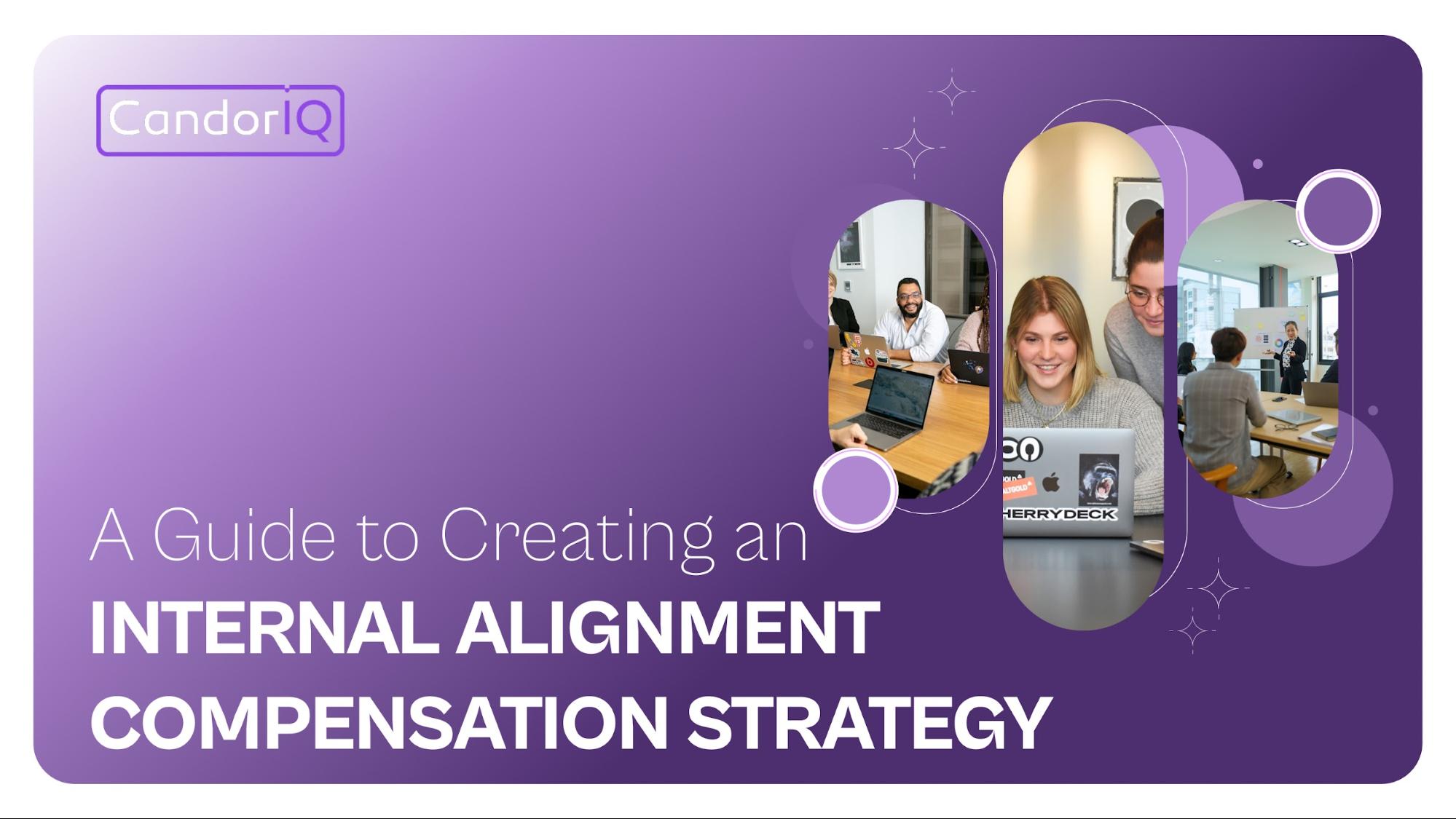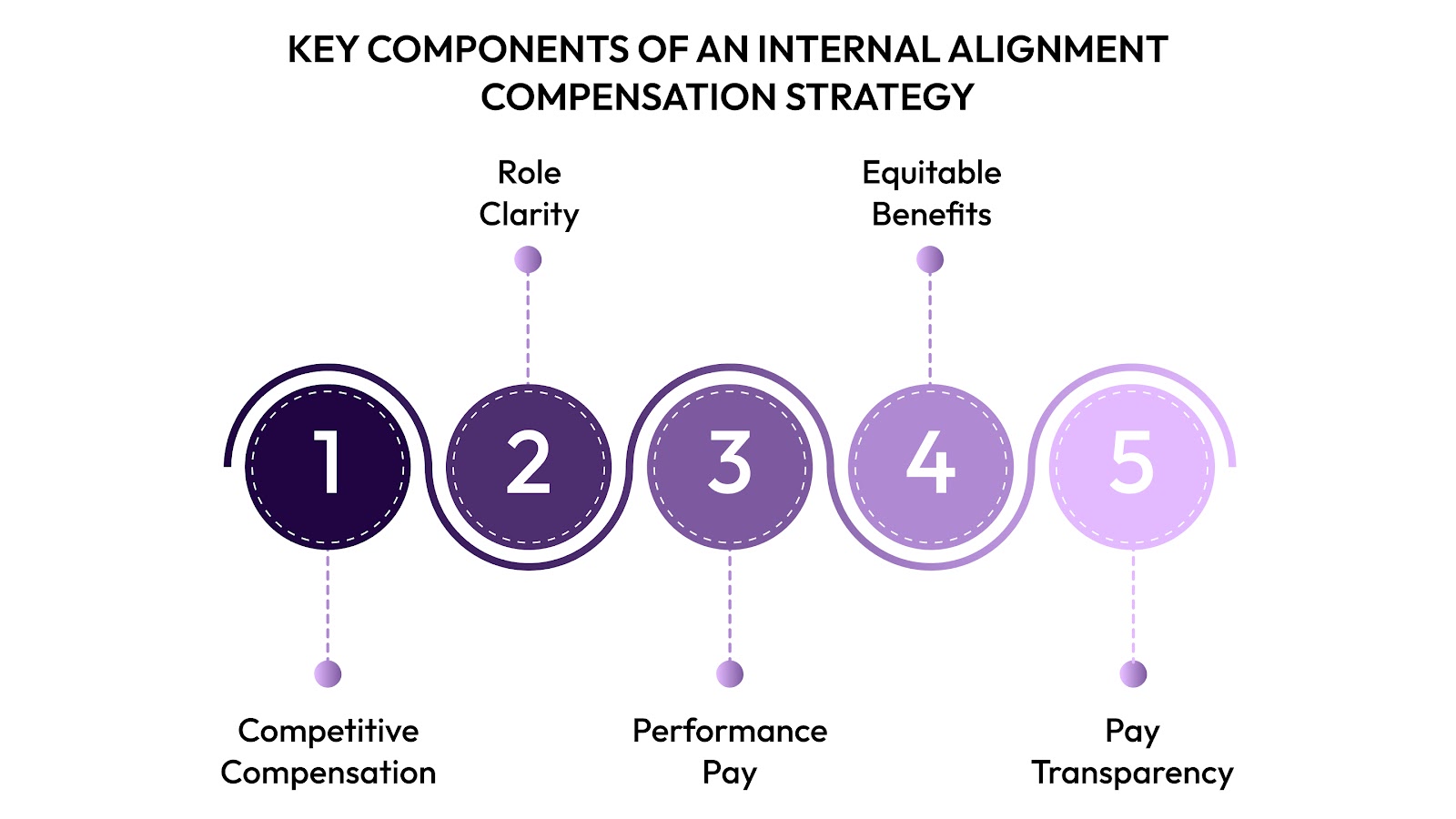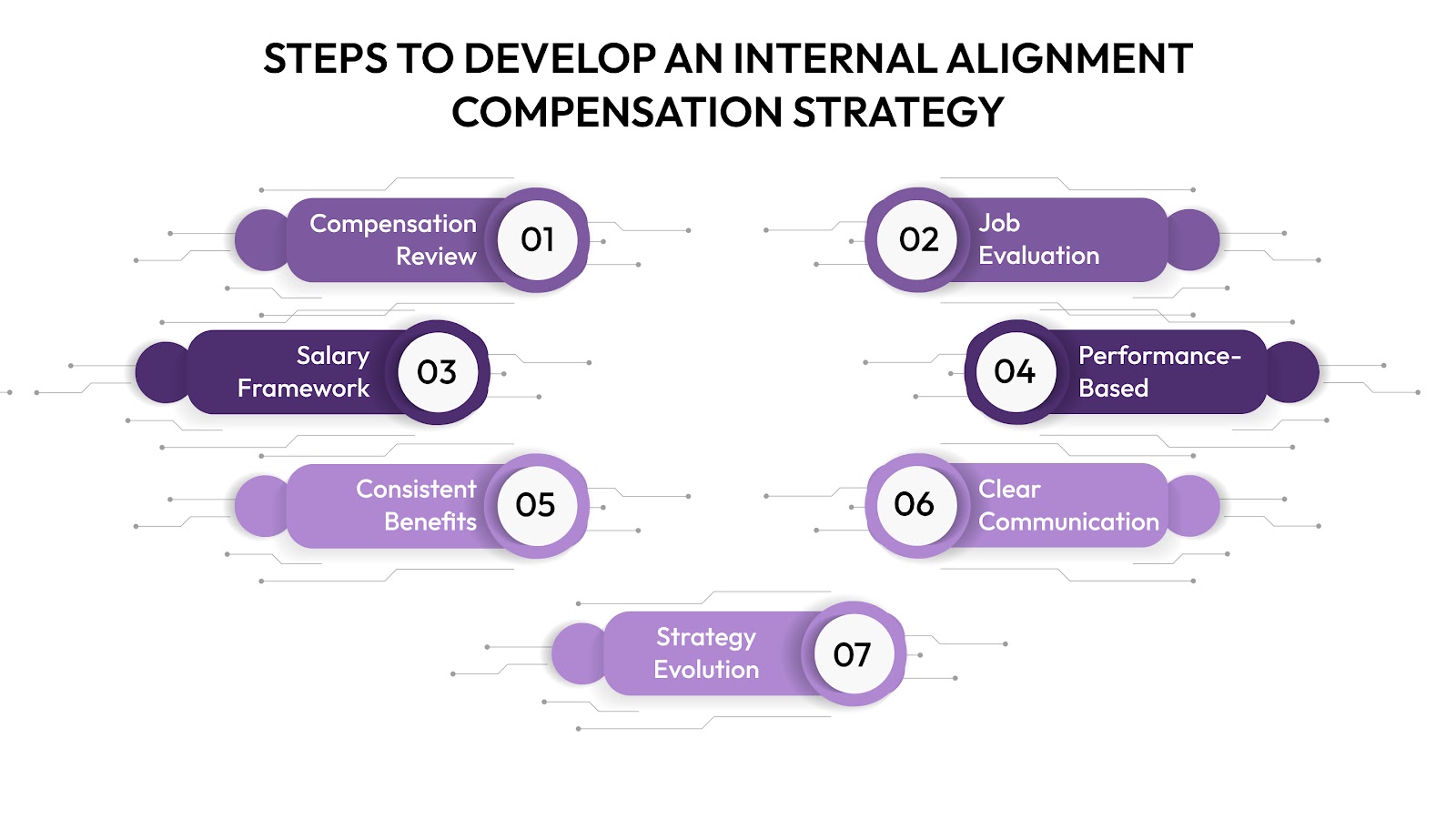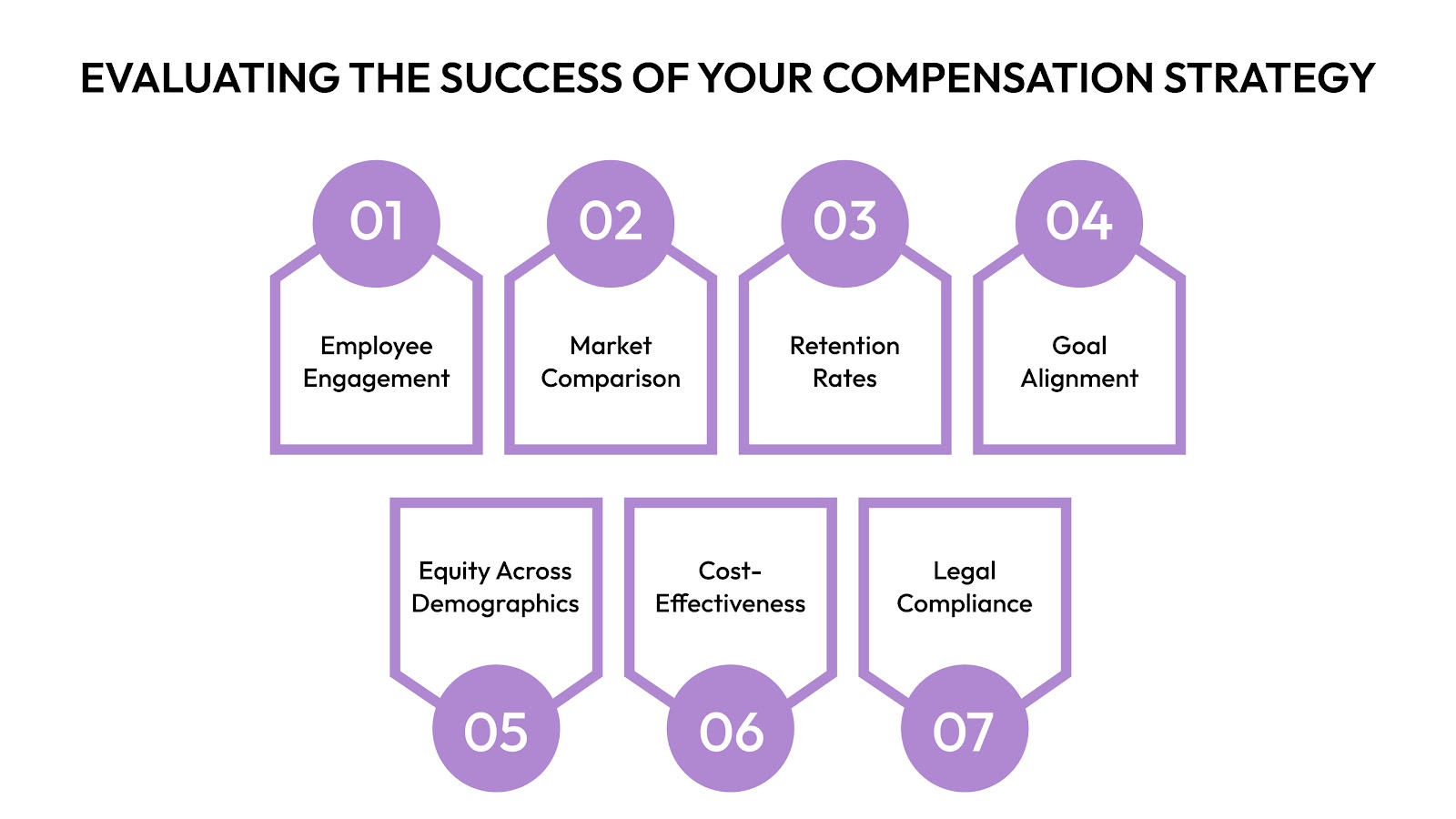A Guide to Creating an Internal Alignment Compensation Strategy
Explore how to build an internal alignment strategy for fair, consistent pay with key steps, best practices, and ways to measure success.

When two people in similar roles are paid very differently, it doesn’t stay under the radar for long, and it can quietly erode trust. In fast-growing companies like tech and SaaS, pay gaps aren’t just about numbers. They reflect deeper cultural challenges.
We know how frustrating it can be for teams when compensation decisions seem inconsistent or unclear, especially in environments where every decision impacts morale and retention.
Without a clear internal alignment strategy, compensation decisions often feel inconsistent or reactive. Over time, that can lead to confusion and frustration, and even drive top performers away.
This guide walks you through the process of building an equitable, consistent, and scalable internal alignment compensation strategy. It also helps you identify key components, offers practical steps, navigates challenges, and measures success.
TL;DR
- Use job evaluations and structured salary bands to ensure fair pay across roles.
- Benchmark regularly to stay competitive without causing internal gaps.
- Tie pay to clear performance goals so employees see the link between effort and rewards.
- Communicate how pay decisions are made to build clarity and trust, even without sharing exact salaries.
What is Internal Alignment in Compensation?
Internal alignment in compensation refers to ensuring that employees are paid fairly and consistently across all roles, teams, and levels within a company. It’s about ensuring that people doing similar work are compensated similarly. They are taking into account their experience, skills, and responsibilities while also staying competitive with market rates.
Compensation includes more than just salary; it also covers benefits like healthcare, retirement plans, and paid time off, all of which play a role in how employees feel valued and treated fairly.
To achieve this, companies often establish clear salary structures, conduct regular compensation audits, and utilize data-driven tools to inform their decisions. When employees feel that their pay reflects their work and is comparable to that of their peers, they’re more likely to stay engaged, motivated, and loyal to the company.
Achieving true internal alignment starts with a clear understanding of the core components that shape an equitable and reliable compensation strategy.
Key Components of an Internal Alignment Compensation Strategy

A well-structured compensation strategy focuses on a few important areas to ensure pay stays fair, consistent, and competitive across the company. These elements help connect your pay decisions with both company goals and what your employees care about..
Here are the key elements to consider:
- Staying Competitive with Market Pay: Internal alignment must keep pace with the external job market to remain competitive. Balancing internal equity with market competitiveness is crucial for attracting and retaining top talent.
- Group Roles Clearly Defined and Set Fair Pay Ranges: Organizing roles by responsibilities, required skills, and business impact enables structured job evaluations. Grouping similar roles into defined salary structures reduces bias.
- Compensation Based on Performance: Linking pay to performance encourages accountability and motivation. When raises, bonuses, or equity are tied to clear KPIs, compensation reflects actual contributions, provided the criteria are transparent and measurable.
- Keep Benefits Equitable for Everyone: Even if salaries differ by role or level, benefits should remain equitable. A consistent package, including healthcare, retirement plans, and paid leave, shows that every employee is valued.
- Be Open About How Pay Is Decided: Helping employees understand how decisions are made builds trust from the start. Open communication regarding pay structures, evaluation criteria, and growth opportunities encourages trust and engagement.
Now that you know what a strong compensation strategy includes, let’s look at how to put it into action, step by step.
Also Read: A Comprehensive Guide to Conducting Compensation Analysis
Steps to Develop an Internal Alignment Compensation Strategy

Building a strong internal alignment compensation strategy is key to maintaining equity and competitiveness across your organization. For U.S.-based tech and SaaS companies, getting this right not only supports a healthy work culture but also plays a significant role in attracting and retaining top talent.
Here’s a look at the core steps involved in creating a well-aligned compensation strategy:
1. Assess Your Current Compensation Practices
Before developing a new strategy, review what’s already in place. This includes reviewing salary data, benefits packages, and any pay disparities. A thorough compensation audit helps benchmark against industry standards and reveals internal pay gaps that need attention.
2. Conduct a Clear Job Evaluation
Use structured job evaluations based on skills, responsibilities, and impact to inform fair salary ranges and group roles appropriately. A good way to start is by using a point-factor system or job leveling guide that breaks roles down by responsibilities, decision-making scope, and required skills. By grouping similar roles and creating a structured salary, you can ensure unbiased compensation across the board.
3. Define Salary Structures and Salary Ranges
Once roles are clearly evaluated, establish salary structures that reflect both internal equity and external market trends. Consider factors like experience, performance, and geographic differences to create a balanced and competitive pay structure.
To define your ranges, pull in compensation data from trusted sources like Payscale, Levels.fyi, or Radford. Then, organize roles by levels, like junior, mid, and senior, so you can offer a clear path for growth and ensure pay aligns with skill and experience.
4. Link Compensation to Performance
Aligning pay with performance reinforces accountability and drives results. Implement a performance review system tied to clear Key Performance Indicators (KPIs) so employees understand how their contributions influence raises, bonuses, or equity.
Make sure the KPIs you use are clear, measurable, and role-specific. For example, sales teams might be measured on revenue closed, while product managers could be evaluated based on project delivery or feature adoption. This clarity helps employees understand exactly what’s expected.
5. Keep Benefits Consistent Across the Board
Even when salaries vary, benefits should remain equitable. Regularly review offerings like healthcare, retirement plans, and paid time off to ensure they are consistent and aligned with both employee needs and market expectations.
6. Communicate Clearly and Openly
Transparency around compensation builds trust and engagement. Share your compensation philosophy, explain how decisions are made, and clarify how roles and performance factor into pay, making the process feel fair and predictable.
7. Monitor and Evolve Your Strategy
Internal alignment isn’t a one-time task; it’s a continuous process. Schedule regular reviews of your compensation strategy, utilizing audits, employee feedback, and market insights to ensure it remains relevant as your company and workforce evolve.
Even with a solid strategy in place, aligning internal compensation isn’t always straightforward. Real-world challenges can arise along the way.
Challenges & Solutions in Aligning Internal Compensation
In fast-moving industries like technology and SaaS, where talent competition is intense, achieving internal alignment can be challenging. For instance, two engineers at the same level, one in product and the other in infrastructure, are doing similar work but receiving very different pay.
Situations like this are more common than you’d think and often spark frustration and disengagement across teams. Here are some common challenges that companies face in this area, along with practical ways to overcome them.
While challenges are inevitable, many of them can be avoided or minimized with the right systems in place.
Best Practices for Maintaining Internal Alignment

Keeping internal compensation aligned is not a one-time task; it’s an ongoing effort. It takes attention to detail, regular check-ins, and a real commitment to fairness across the board. To ensure your compensation remains competitive, review it regularly to align with company goals and the expectations of your employees.
Here are some best practices to help you stay on track:
- Review and Update Compensation Regularly: Compensation shouldn’t be static. Set a schedule once or twice a year to review your structure and benchmark against the market. Adjust salary structures to stay competitive and aligned with evolving employee needs.
- Run Regular Compensation Audits: Audits help catch disparities early and ensure fair pay across roles and demographics, especially when powered by platforms like CandorIQ.. Use findings to correct gaps and keep practices aligned with performance and market trends.
- Connect Compensation to Performance: Tie compensation to clear, measurable results. Use performance reviews linked to KPIs to reward top performers through raises, bonuses, or stock options.
- Be Transparent About Pay Decisions: Clearly communicate how compensation is determined, how roles are evaluated, what drives increases, and the role of performance.
- Offer Flexible Benefits: One-size-fits-all benefits don’t work. Offer customizable options, like multiple health plans, learning stipends, or remote work support, so employees can choose what fits their needs.
- Link Pay to Career Growth: Show employees a clear path to advancement. Tie compensation to development by offering training, leadership programs, and progression tracks that lead to higher pay.
- Address Pay Disparities Promptly: Regularly analyze pay data for gaps across roles or demographics. If discrepancies arise, act promptly to correct them and enhance evaluation processes.
- Let Values Guide Your Pay Strategy: Compensation should reflect what your company stands for. If you value innovation, reward original thinking and problem-solving. If collaboration is a core principle, recognize and celebrate team-driven success.
- Involve Leadership: Engage senior leaders in shaping and communicating the compensation strategy. Their involvement reinforces alignment with business goals and demonstrates a commitment to fair pay.
- Build a Culture of Recognition: To reinforce a positive culture, encourage both formal and informal recognition, shout-outs, awards, or simple thank-yous.
Putting these practices into action is just one part of the equation. To keep your compensation strategy effective and relevant, it’s important to regularly evaluate its impact and adjust as needed.
Also Read: Understanding Performance-Based Compensation: Pros and Cons
Evaluating the Success of Your Compensation Strategy

Evaluating your compensation strategy is crucial to ensure it’s effective, helping you meet business goals, keeping employees satisfied, and staying competitive in the market. Regular check-ins enable you to identify what’s working, what’s not, and where you can make improvements.
Here are some key ways to measure how successful your compensation strategy is:
- Employee Satisfaction and Engagement: High satisfaction and engagement levels, measured through surveys and retention data, indicate that employees feel fairly compensated.
- Competitive Market Comparison: Regular benchmarking against industry standards ensures your pay structure remains competitive and helps attract and retain talent.
- Retention and Turnover Rates: Low turnover, especially among top performers, signals that your compensation effectively supports employee retention.
- Alignment with Company Goals: When pay is tied to individual and business performance, it drives results and aligns employee efforts with company objectives.
- Equity Across Demographics: Consistent, merit-based pay across roles and demographics reflects a fair and inclusive compensation strategy.
- Cost-Effectiveness: A sustainable compensation structure balances employee satisfaction with financial efficiency and measurable ROI.
- Legal Compliance: Regular audits and legal awareness ensure your compensation practices meet all labor regulations and avoid risk.

Wrapping Up
When you build a strategy that’s clear, consistent, and backed by data, you’re doing more than just ensuring fair pay. You’re strengthening trust, improving retention, and setting your company up for long-term success. As your team grows, having a solid framework makes it easier to stay aligned and keep everyone moving in the same direction.
CandorIQ helps you do just that. With tools to build a structured salary, compare roles internally, and tap into real-time market data, you can make confident, data-informed decisions. It's a smarter way to keep your compensation strategy fair, flexible, and future-ready.
Book a demo with CandorIQ today to see how it can help you build a fair, transparent, and scalable compensation strategy.
Also Read: How to Create an Effective Employee Incentive Plan
FAQs
Q1. How do job evaluations support internal alignment?
A1. Job evaluations help assess the value of each role based on responsibilities, skills, and impact. This makes it easier to group similar roles and ensure equitable, consistent compensation across the organization.
Q2. Should performance factor into internal alignment?
A2. Yes, connecting compensation to performance ensures rewards reflect actual contributions. Clear metrics ensure a fair process and encourage high performance.
Q3. How is internal alignment different from external competitiveness?
A3. Internal alignment focuses on fair pay within the company. On the other hand, external competitiveness compares your pay to market standards. A strong strategy balances both retaining and attracting talent.
Q4. How do you explain pay decisions without revealing individual salaries?
A4. You need to focus on the how. Share the structure, criteria, and factors behind pay decisions, like job level or performance, without disclosing anyone’s specific salary.


